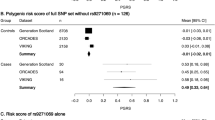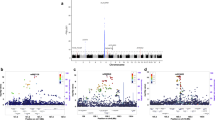Abstract
A recent genome-wide association study (GWAS) conducted by the International Multiple Sclerosis Genetics Consortium (IMSGC) identified a number of putative MS susceptibility genes. Here we have performed a replication study in 1134 Australian MS cases and 1265 controls for 17 risk-associated single nucleotide polymorphisms (SNPs) reported by the IMSGC. Of 16 SNPs that passed quality control filters, four, each corresponding to a different non-human leukocyte antigen (HLA) gene, were associated with disease susceptibility: KIAA0350 (rs6498169) P=0.001, IL2RA (rs2104286) P=0.033, RPL5 (rs6604026) P=0.041 and CD58 (rs12044852) P=0.042. There was no association (P=0.58) between rs6897932 in the IL7R gene and the risk of MS. No interactions were detected between the replicated IMSGC SNPs and HLA-DRB1*15, gender, disease course, disease progression or age-at-onset. We used a novel Bayesian approach to estimate the extent to which our data increased or decreased evidence for association with the six most-associated IMSGC loci. These analyses indicated that even modest P-values, such as those reported here, can contribute markedly to the posterior probability of ‘true’ association in replication studies. In conclusion, these data provide support for the involvement of four non-HLA genes in the pathogenesis of MS, and combined with previous data, increase to genome-wide significance (P=3 × 10−8) evidence of an association between KIAA0350 and risk of disease.
This is a preview of subscription content, access via your institution
Access options
Subscribe to this journal
Receive 6 digital issues and online access to articles
$119.00 per year
only $19.83 per issue
Buy this article
- Purchase on SpringerLink
- Instant access to full article PDF
Prices may be subject to local taxes which are calculated during checkout
Similar content being viewed by others
References
Dyment DA, Herrera BM, Cader MZ, Willer CJ, Lincoln MR, Sadovnick AD et al. Complex interactions among MHC haplotypes in multiple sclerosis: susceptibility and resistance. Hum Mol Genet 2005; 14: 2019–2026.
Barcellos LF, Sawcer S, Ramsay PP, Baranzini SE, Thomson G, Briggs F et al. Heterogeneity at the HLA-DRB1 locus and risk for multiple sclerosis. Hum Mol Genet 2006; 15: 2813–2824.
Yeo TW, De Jager PL, Gregory SG, Barcellos LF, Walton A, Goris A et al. A second major histocompatibility complex susceptibility locus for multiple sclerosis. Ann Neurol 2007; 61: 228–236.
Gibbs RA, Belmont JW, Hardenbol P, Willis TD, Yu F, Yang H et al. The International HapMap Project. Nature 2003; 426: 789–796.
Hafler DA, Compston A, Sawcer S, Lander ES, Daly MJ, De Jager PL et al. Risk alleles for multiple sclerosis identified by a genomewide study. N Engl J Med 2007; 357: 851–862.
Gregory SG, Schmidt S, Seth P, Oksenberg JR, Hart J, Prokop A et al. Interleukin 7 receptor alpha chain (IL7R) shows allelic and functional association with multiple sclerosis. Nat Genet 2007; 39: 1083–1091.
Lundmark F, Duvefelt K, Iacobaeus E, Kockum I, Wallstrom E, Khademi M et al. Variation in interleukin 7 receptor alpha chain (IL7R) influences risk of multiple sclerosis. Nat Genet 2007; 39: 1108–1113.
Weber F, Fontaine B, Cournu-Rebeix I, Kroner A, Knop M, Lutz S et al. IL2RA and IL7RA genes confer susceptibility for multiple sclerosis in two independent European populations. Genes Immun 2008; 9: 259–263.
Matesanz F, Caro-Maldonado A, Fedetz M, Fernandez O, Milne RL, Guerrero M et al. IL2RA/CD25 polymorphisms contribute to multiple sclerosis susceptibility. J Neurol 2007; 254: 682–684.
Ramagopalan SV, Anderson C, Sadovnick AD, Ebers GC . Genomewide study of multiple sclerosis. N Engl J Med 2007; 357: 2199–2200; author reply 2200–2201.
Hoppenbrouwers IA, Aulchenko YS, Ebers GC, Ramagopalan SV, Oostra BA, van Duijn CM et al. EVI5 is a risk gene for multiple sclerosis. Genes Immun 2008; 9: 334–337.
Hakonarson H, Grant SF, Bradfield JP, Marchand L, Kim CE, Glessner JT et al. A genome-wide association study identifies KIAA0350 as a type 1 diabetes gene. Nature 2007; 448: 591–594.
Todd JA, Walker NM, Cooper JD, Smyth DJ, Downes K, Plagnol V et al. Robust associations of four new chromosome regions from genome-wide analyses of type 1 diabetes. Nat Genet 2007; 39: 857–864.
Vella A, Cooper JD, Lowe CE, Walker N, Nutland S, Widmer B et al. Localization of a type 1 diabetes locus in the IL2RA/CD25 region by use of tag single-nucleotide polymorphisms. Am J Hum Genet 2005; 76: 773–779.
Lowe CE, Cooper JD, Brusko T, Walker NM, Smyth DJ, Bailey R et al. Large-scale genetic fine mapping and genotype–phenotype associations implicate polymorphism in the IL2RA region in type 1 diabetes. Nat Genet 2007; 39: 1074–1082.
Roxburgh RH, Seaman SR, Masterman T, Hensiek AE, Sawcer SJ, Vukusic S et al. Multiple sclerosis severity score: using disability and disease duration to rate disease severity. Neurology 2005; 64: 1144–1151.
Rubio JP, Bahlo M, Butzkueven H, van Der Mei IA, Sale MM, Dickinson JL et al. Genetic dissection of the human leukocyte antigen region by use of haplotypes of tasmanians with multiple sclerosis. Am J Hum Genet 2002; 70: 1125–1137.
Rubio JP, Bahlo M, Stankovich J, Burfoot RK, Johnson LJ, Huxtable S et al. Analysis of extended HLA haplotypes in multiple sclerosis and narcolepsy families confirms a predisposing effect for the class I region in Tasmanian MS patients. Immunogenetics 2007; 59: 177–186.
Burfoot RK, Jensen CJ, Field J, Stankovich J, Varney MD, Johnson LJ et al. SNP mapping and candidate gene sequencing in the class I region of the HLA complex: searching for multiple sclerosis susceptibility genes in Tasmanians. Tissue Antigens 2008; 71: 42–50.
Rubio JP, Bahlo M, Tubridy N, Stankovich J, Burfoot R, Butzkueven H et al. Extended haplotype analysis in the HLA complex reveals an increased frequency of the HFE-C282Y mutation in individuals with multiple sclerosis. Hum Genet 2004; 114: 573–580.
Poser CM, Paty DW, Scheinberg L, McDonald WI, Davis FA, Ebers GC et al. New diagnostic criteria for multiple sclerosis: guidelines for research protocols. Ann Neurol 1983; 13: 227–231.
McDonald WI, Compston A, Edan G, Goodkin D, Hartung HP, Lublin FD et al. Recommended diagnostic criteria for multiple sclerosis: guidelines from the International Panel on the diagnosis of multiple sclerosis. Ann Neurol 2001; 50: 121–127.
Paty DW, Oger JJ, Kastrukoff LF, Hashimoto SA, Hooge JP, Eisen AA et al. MRI in the diagnosis of MS: a prospective study with comparison of clinical evaluation, evoked potentials, oligoclonal banding, and CT. Neurology 1988; 38: 180–185.
Kimura A, Sasasuki T . Eleventh International Histocompatibility Workshop Reference Protocol for the HLA DNA-Typing Technique. In: Tsuji K, Aizawa M, Sasazuki T (eds). HLA 1991. Oxford University Press: Oxford, New York, Tokyo, 1991, pp 397–419.
Kotsch K, Wehling J, Blasczyk R . Sequencing of HLA class II genes based on the conserved diversity of the non-coding regions: sequencing based typing of HLA-DRB genes. Tissue Antigens 1999; 53: 486–497.
Purcell S, Cherny SS, Sham PC . Genetic power calculator: design of linkage and association genetic mapping studies of complex traits. Bioinformatics 2003; 19: 149–150.
Barrett JC, Fry B, Maller J, Daly MJ . Haploview: analysis and visualization of LD and haplotype maps. Bioinformatics 2005; 21: 263–265.
Wakefield J . A Bayesian measure of the probability of false discovery in genetic epidemiology studies. Am J Hum Genet 2007; 81: 208–227.
Acknowledgements
We are grateful to people with MS who have participated in this study and to staff at The Royal Melbourne Hospital and Menzies Research Institute who were involved in recruitment of MS patients. JPR and MB are supported by Biomedical Career Development Awards from the Australian National Health and Medical Research Council (NHMRC). HB is supported by a Peter Doherty Post-doctoral Fellowship (NHMRC). SJF and TPS are Senior Principal Research Fellows of the NHMRC. This work was supported by Charity Works for MS, and an NHMRC Project grant (App ID 509184). The Broad Institute Center for Genotyping and Analysis is supported by grant U54 RR020278 from the National Center for Research Resources.
Author information
Authors and Affiliations
Corresponding author
Additional information
Supplementary Information accompanies the paper on Genes and Immunity website (http://www.nature.com/gene)
Supplementary information
Rights and permissions
About this article
Cite this article
Rubio, J., Stankovich, J., Field, J. et al. Replication of KIAA0350, IL2RA, RPL5 and CD58 as multiple sclerosis susceptibility genes in Australians. Genes Immun 9, 624–630 (2008). https://doi.org/10.1038/gene.2008.59
Received:
Revised:
Accepted:
Published:
Issue Date:
DOI: https://doi.org/10.1038/gene.2008.59
Keywords
This article is cited by
-
Interleukin-2 receptor-α proximal promoter hypomethylation is associated with multiple sclerosis
Genes & Immunity (2017)
-
Association between the IL7R T244I polymorphism and multiple sclerosis risk: a meta analysis
Neurological Sciences (2016)
-
Where is the causal variant? On the advantage of the family design over the case–control design in genetic association studies
European Journal of Human Genetics (2015)
-
CD58 polymorphisms associated with the risk of neuromyelitis optica in a Korean population
BMC Neurology (2014)
-
Multiple sclerosis-associated single-nucleotide polymorphisms in CLEC16A correlate with reduced SOCS1 and DEXI expression in the thymus
Genes & Immunity (2013)



